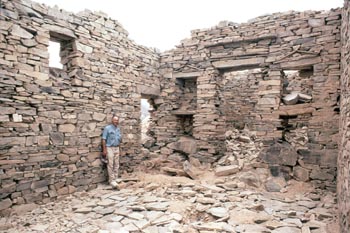|
June 18, 2002--As an archeologist, Steven Sidebotham, University of Delaware professor of history, wears several hats—detective, excavator, surveyor, trash collector, historian and interpreter—literally uncovering the secrets of ancient Egypt through excavations and explorations of the port of Berenike on the Red Sea plus the "emerald city" of Sikait, site of deserted emerald mines. 
Sidebotham serves as co-director, with Willemina Wendrich of the University of California in Los Angeles, of the Berenike Project where he has been working since 1994. He also is director of the Sikait Project.
He and various coauthors have written recent articles on each site—“Berenike: A Ptolemaic-Roman Port on the Ancient Maritime Spice and Incense Route” in the May/June issue of Minerva, The International Review of Ancient Art and Archaeology, and “Emerald City” in the June issue of Archeology, a publication of the Archaeological Institute of America.
“Berenike was an active port from the third century B.C. to the sixth century A.D. when it was deserted,” Sidebotham said. “We can only speculate what happened—silt filling the harbor, a plague from Africa, which may have spread to the city, or competition from South Arabia or the African kingdom of Axum, which controlled the entrance to the Red Sea.
“Berenike has portions of some buildings which are visible above ground, but most of the city is buried. The buildings are multi-storied, one civilization building upon the buildings of another. What we are seeking is knowledge of the city and its inhabitants for the 800 years when it was in existence through digging trenches, one not yet completed is already 17 feet deep, at different key locations. Our goal is not to try to excavate the city, but to learn about the past,” Sidebotham said.
Some discoveries about the port come as flashes of insight. Sidebotham recalled that he walked over a section of the site several times a day for years without really noticing it. Then one day he observed that there were numerous basalt rocks from volcanoes lying around—not a part of the natural desert landscape. Sidebotham said he realized that the basalt must have been used as ballast by ships coming to Berenike, and that the rocks had been dumped in what was probably the old Ptolemaic harbor site. Future excavations may prove his hypothesis to be right.
The old adage that one person’s trash is another’s treasure certainly applies to archaeology. Rubbish sites are important in giving archeologists clues about the lives and occupations of people in past civilizations, he said. Bones, shells and seeds reveal what foods they ate and what animals they kept, pottery shards from different periods and places tell about former occupants of the city; pieces of written documents reveal trade transactions.
Other artifacts show Berenike’s importance along the trade route. South Indian black peppercorns and dinnerware, beads from Java, Thailand or Vietnam and Sri Lanka, coins from ancient Axum—all have a story to tell. Buildings and artifacts show that both poor and wealthy people inhabited the port.
An elephant’s tooth indicated that elephants were imported and exported through the port. “Elephants were the tanks of antiquity and very important for warfare in the ‘classical’ world in the third and second centuries B.C.,” Sidebotham said.
Discoveries have revealed that 11 written languages, two of which have not yet been identified, were used in the city, and there is evidence of eight religious cults—including Egyptian and Roman gods, Christianity and Judaism—indicating the diversity of life and culture in the ancient port.
Unlike Berenike, the buildings and temples at Sikait are visible. To the layperson, it may look more important and impressive than Berenike, Sidebotham said. However, Berenike was a major port and the crossroads of many civilizations, and Sikait existed only for mining emeralds.
Although it was known that the emerald mines existed from the writings of ancient authors, no one knew their exact location until they were rediscovered by the French explorer Frédéric Cailliaud. On a survey with a Bedouin guide in 1991, Sidebotham first visited the site. Work is underway to excavate and preserve ancient Sikait and will continue this summer.
The climate is harsh with the summer heat—so hot it cannot be registered on an ordinary thermometer, Sidebotham said.
Vandalism and robbery are problems at these ancient sites, Sidebotham said. Cailliaud described a city still standing and intact, but the past few hundred years have taken their toll. The temple is full of rubble and debris, unlike the temple sketched by Cailliaud in 1817. The only tombs that have been discovered have all been robbed.
In ancient times, eastern Egypt was the only source of emeralds for the classical Mediterranean world. Although emeralds are still present in Sikait, Sidebotham said, they are inferior to those from Colombia, and there is no interest in mining them today.
Sidebotham said the goal of the Sikait Project is to excavate selected areas and restore and reconstruct buildings and survey the region looking for other sites. “We must preserve this site for future generations,” he said.
Both projects have received support from a variety of sources, including the National Geographic Society, the Samuel H. Kress Foundation, the National Endowment for the Humanities and generous individual donors.
Article by Sue Moncure
|

